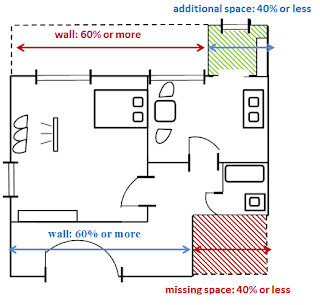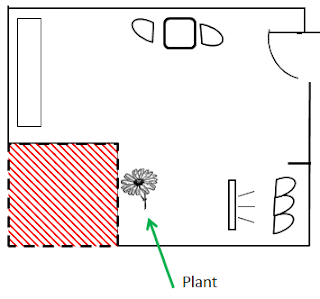I posted already about how to identify missing spaces and corners. Remember: first, identify where the vaious Bagua areas in your home are located, second: determine whether you are dealing with an additional or missing space using the 60% - 40% rule:
How to activate and balance energy in a missing space or corner:
There are various cures and remedies you can use to activate and / or balance the lack of energy in a missing space or corner.
Let's look at an example. We've got a living room here with a missing space. The missing space is highlighted in red:
Cures and remedies could be:
- Mirror
Place a mirror on one of the walls next to the missing space:
Things to mind: as always when working with mirrors, be careful that the main entrance is not opposite the mirror (or reflected in the mirror), ensure that the mirror reflects something positive and nice (because the mirror symbolically 'doubles' what is reflected in it: that could be your fridge - which symbolically doubles your food and hence, your finances and wealth, or it could be old laundry, which will be 'doubled' as well by the mirror....) and try to buy a mirror of a high quality.
- Water fountain
Here are my tips on what to mind if you decide to use water fountains in your flat or house.
Instead of a water fountain, you could also use a picture of a water fall.
- Plants
Plants are always a good way to stabilise and add Chi energy. Place the plant next to the missing corner:
However: use large plants rather than a couple of flowers in a vase. Flowers have less Chi energy because they have been parted from their roots and can't grow or expand anymore.
- Light
- Strengthen the element of the missing space
Obviously, objects and decorations resembling a certain element should be placed next to the missing space or corner.
Things to mind when activating or balancing a missing corner or space:
- Mind the element of that corner
Find out in what Bagua sector the missing space is located (have a look here to find out how to do that). Then determine the element that Bagua sector is associated with. As mentioned, for the Southwest, for example, that would be earth. Be mindful that the cures and remedies used to activate the missing space do not weaken the element of that Bagua area. If the missing corner is in the Southwest, for instance, it would not be a good idea to place a very big plant there, because the element wood (represented by plants) weakens the element earth.
Another example: if the missing corner is located in the South (associated with the element fire), don't place a water fountain or waterfall picture there, because water weakens the element fire. - Mirrors
I already mentioned that you need to be careful when using mirrors. Mirrors are a strong Feng Shui device and, in my opinion, the best way to activate a missing space or corner. But be mindful of what is reflected in the mirror: it should not be the main entrance, negative or unhappy-looking objects, open or hidden 'Feng Shui arrows'... Mirrors are highly effective when used to balance a missing space, but they can be equally harmful when the wrong objects are reflected in the mirror.

















































